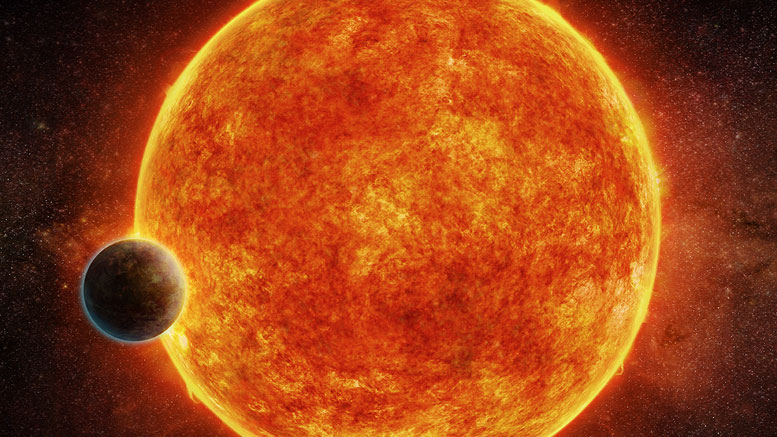
An artist’s impression of the newly-discovered rocky exoplanet, LHS 1140b. This planet is located in the liquid water habitable zone surrounding its host star, a small, faint red star named LHS 1140. The planet weighs about 6.6 times the mass of Earth and is shown passing in front of LHS 1140. Depicted in blue is the atmosphere the planet may have retained.
Astronomers are moving to the next phase of studying alien worlds – searching for signs of life on planets outside our Solar System. And the newly discovered “super-Earth” LHS 1140 b, which orbits in the habitable zone of a nearby small star, is at the top of that list.
“This is the most exciting exoplanet I’ve seen in the past decade,” said lead author Jason Dittmann of the Harvard-Smithsonian Center for Astrophysics (CfA). “We could hardly hope for a better target to perform one of the biggest quests in science − searching for evidence of life beyond Earth.”
You can read about the newfound planet in the April 20th issue of the journal Nature.
Astronomers found the planet using the transit method – when a star dims as a planet crosses in front of it as seen from Earth. By measuring how much light this planet blocks, the team determined that it is about 11,000 miles in diameter, or about 40 percent larger than Earth. They also reveal that it is located just 40 light-years away.
The team has also weighed the planet to be 6.6 times the mass of Earth, showing that it is dense and likely has a rocky composition. Small, potentially habitable planets have been found in the TRAPPIST-1 system, located a similar distance from Earth, but only one of those worlds has had its density measured accurately, showing that it isn’t rocky. Therefore, some or all of the others also might not be rocky.
Since this planet transits its star, unlike the closest world to the solar system Proxima Centauri b, it can be examined for the presence of air. As the planet moves in front of the star, the star’s light will be filtered through any atmosphere and leave an imprint. Large, next-generation telescopes will be needed to tease out these subtle signals.
“This planet will be an excellent target for the James Webb Space Telescope when it launches in 2018, and I’m especially excited about studying it with the ground-based Giant Magellan Telescope, which is under construction,” said co-author David Charbonneau of the CfA.
The planet orbits a tiny, faint star known as LHS 1140, which is only one-fifth the size of the Sun. Since the star is so dim and cool, its habitable zone (the distance at which a planet might be warm enough to hold liquid water) is very close. This planet, designated LHS 1140 b, orbits its star every 25 days. At that distance, it receives about half as much sunlight from its star as Earth.
Although the planet is potentially habitable now, it might have faced a hellish past. When the star was young, it would have bathed the planet in a harsh ultraviolet glare that could have stripped any water from the atmosphere, leading to a runaway greenhouse effect like we see on Venus.
However, since the planet is larger than Earth, it might have possessed a magma ocean on its surface for millions of years. Powered by heat from naturally radioactive elements, that churning ocean of lava may have fed steam into the atmosphere long after the star calmed to its current, steady glow. This process could have replenished the planet with water, making it suitable for life as we know it.
This artist’s impression video shows an imaginary trip to the exoplanet LHS 1140b, which orbits a red dwarf star 40 light-years from Earth and may be the new holder of the title “best place to look for signs of life beyond the Solar System.”
“Right now we’re just making educated guesses about the content of this planet’s atmosphere,” said Dittmann. “Future observations might enable us to detect the atmosphere of a potentially habitable planet for the first time. We plan to search for water, and ultimately molecular oxygen.”
In contrast with the TRAPPIST-1 star, LHS 1140 spins slowly and does not emit much high-energy radiation, which also may help the likelihood of life on its planet.
LHS 1140 b was discovered using the MEarth-South telescope array at Cerro Tololo Inter-American Observatory. This collection of eight telescopes, with its companion facility MEarth-North, studies faint, red stars known as M dwarfs to locate orbiting planets using the transit method.
In follow-up work the team was able to detect LHS 1140 wobbling as the planet orbits it, using the High Accuracy Radial velocity Planet Searcher (HARPS) installed on the European Southern Observatory’s 3.6m telescope at La Silla Observatory in Chile. This information was combined with data from the transit method, allowing the team to make good measurements of the planet’s size, mass, and density.
Reference: A temperate rocky super-Earth transiting a nearby cool star” by Jason A. Dittmann, Jonathan M. Irwin, David Charbonneau, Xavier Bonfils, Nicola Astudillo-Defru, Raphaëlle D. Haywood, Zachory K. Berta-Thompson, Elisabeth R. Newton, Joseph E. Rodriguez, Jennifer G. Winters, Thiam-Guan Tan, Jose-Manuel Almenara, François Bouchy, Xavier Delfosse, Thierry Forveille, Christophe Lovis, Felipe Murgas, Francesco Pepe, Nuno C. Santos, Stephane Udry, Anaël Wünsche, Gilbert A. Esquerdo, David W. Latham and Courtney D. Dressing, 20 April 2017, Nature.
DOI: 10.1038/nature22055
arXiv

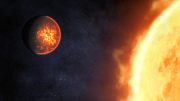
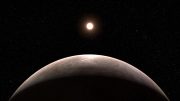
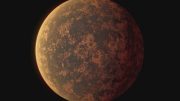
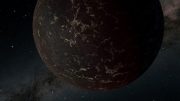
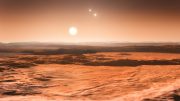
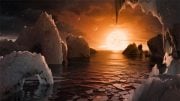
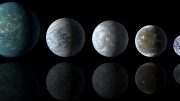
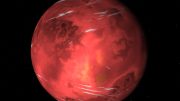
What sort of gravity are we talking about, here? Prohibitive for Earth humans, I would have thought…
Well it would be 6.6g’s because its 6.6 times the mass of earth. Most people black out around 6-7g because our hearts can’t pump blood against the gravity to our brains. With a “g” suit like a pilot wears theoretically we could walk, albeit with great difficulty but it would be possible.
does anyone know why LHS 1140 was named the way it is?